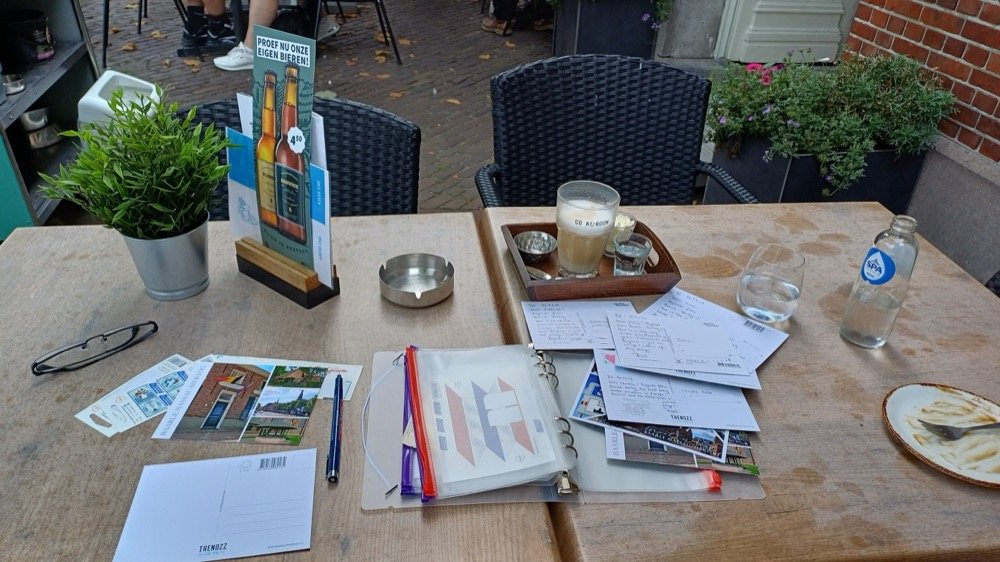For many postcrossers, the travel mode is a welcome change and a great way to pursue our hobby on vacation or while on business trips. Sending postcards from a new country with that country’s postcard ID is always exciting!
But there are some places in the world where you can send your cards in travel mode from two different countries at the same time! Frank (aka xmyrxn) visited a very special place and shares his experience:
"I spent my summer holidays in the Netherlands and made a day trip to the town of Baarle. Indeed Baarle is not just one town but literally two towns in one. So when you enter the city there are two signs displaying Baarle-Nassau (Netherlands) and Baarle-Hertog (Belgium).
If you take a look at the map you find out that there are some Belgian areas within the Dutch territory. But it’s not just a Belgian exclave within the Netherlands, it’s a patchwork of different sized exclaves and enclaves! There are even spots of the Netherlands within a Belgian area which is surrounded by the Netherlands again! To make it just a bit more complicated, the border lines don’t stop at the front doors but cut houses so that your kitchen may be in Belgium and your living room in the Netherlands! Crazy, isn’t it?

When walking through the town you will cross the border several times and it may happen that you wonder in which municipality you actually are. For a better overview all house numbers show the flag of the actual country. And usually the house belongs to the country in which the entrance lies. You also can see the border demarcation on the ground.

But how has this strange situation arisen? Well, long story short: It all began in the dark Middle Ages. The border’s complexity results from numerous medieval treaties, agreements, land swaps and sales between the Lords of Breda and the Dukes of Brabant. Later on Breda became a possession of the House of Nassau, then Nassau-Oranje and finally the Netherlands while the parcels owned by the Dukes (in Flemish, the word Duke translates to “Hertog”) of Brabant went to the Duchy of Burgundy and finally became part of Belgium.

So how is the situation today? In Baarle-Nassau/Hertog you can find the best things from both countries: Cheese, stroopwafels and liquorice from the Netherlands as well as Belgian chocolates, frites and monastery beers.
And more: There’s a Dutch garbage truck in the streets and a Belgian as well, there are Dutch and Belgian schools (and some Dutch children go to the Belgian school and vice versa since the languages Dutch and Flemish are very similar). And there are Dutch and Belgian policemen, sharing a joint police office!And yes, there are two postal systems!

A Belgian post office bpost can be found in Baarle-Hertog and a Dutch PostNL service desk in a stationery shop in Baarle-Nassau.
So I thought I could go into travel mode and send two postcards from the Netherlands. And then two from Belgium. And again two postcards from the Netherlands and finally two more from Belgium.
The only challenge was finding WIFI from both countries to proove Postcrossing that I am sending from these countries. I found free Dutch wifi in a really nice café in Baarle-Nassau and Belgian wifi only a few meters up the street in a pub in Baarle-Hertog. Koffie met Gebak in the Netherlands and a cool drink in Belgium. Could be worse!
After drawing the addresses I decided to try something crazy: Putting stamps of both countries on some of the postcards and collecting the postmarks of both post offices!

Thanks to the kind and helpful staff in both post offices I was able to receive the local handstamp postmarks! Usually nearly all mail of both countries is cancelled in big sorting centres and not postmarked locally anymore. So I think these postcards are very special and I’m a little bit proud to bring some nice mail items into Postcrossing. Four cards went to the USA, three to Russia, two to China and two to Ukraine.

And of course I sent one to myself ;-)"















